Olympus M.ZUIKO Digital ED 9-18mm f/4-5.6 Review
-
Ease
of Use -
Sample
Images -
Lens
Specs -
Rating &
Conclusion -
Main
Rivals -
Review
Roundup - Comment
-
More…

Sharpness
Sharpness at 9mm
The sharpness tests for this review were carried out using a real-world subject rather than a test chart. The Olympus M.ZUIKO 9-18mm f4-5.6 lens was attached to an Olympus E-P2 compact system camera, which in turn was mounted on a sturdy tripod. The self-timer was used to avoid any vibrations from pressing the shutter release. Slight tonal changes are due to slight changes in natural light during the session. The 100% crops represent about 1/300th of the total frame area.
 The full frame at 9mm
The full frame at 9mm
Centre sharpness is best at f/4, i.e. wide open. Diffraction starts to limit performance at as low a value as f/5.6, which is no wonder given that the physical size of the aperture is already very small at that setting (9/5.6=1.6mm), although quality remains acceptable through f/8. You may argue that a 9mm lens doesn't ever need to be stopped down beyond that point anyway, but it isn't always true - when you include a foreground interest that's only a few inches away from the front lens element (as is often the case with an ultra-wide optic), you might find that some parts are out of focus due to depth of field still being insufficient. Have a look at image #7 on our Sample Images page for an example.
The extreme borders never get tack sharp - to minimise blurring at the edges, shoot for f/5.6, but don't expect miracles.
| Aperture | Centre Crop | Edge Crop |
| f/4 |
 |
 |
| f/5.6 |
 |
 |
| f/8 |
 |
 |
| f/11 |
 |
 |
| f/16 |
 |
 |
| f/22 |
 |
 |
-
Ease
of Use -
Sample
Images -
Lens
Specs -
Rating &
Conclusion -
Main
Rivals -
Review
Roundup - Comment
